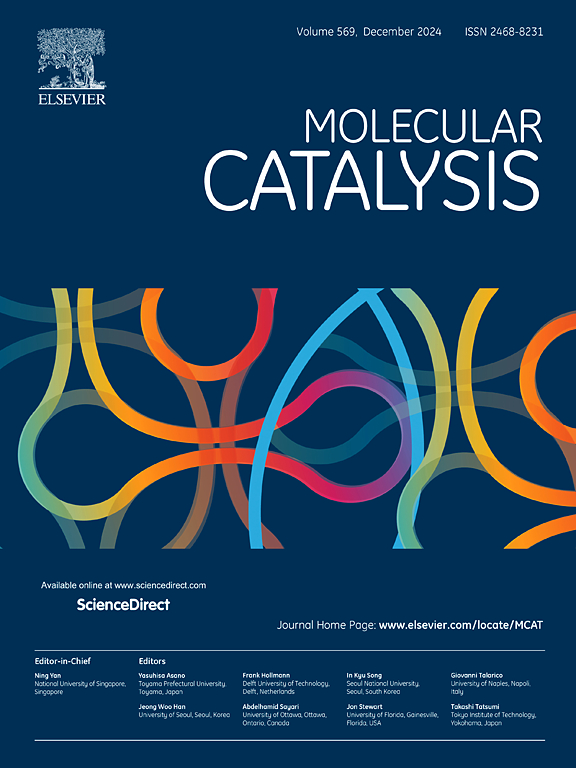On the Mechanism of Acrylate and Propionate Silyl Esters Synthesis by Ruthenium-Catalyzed Coupling of CO2 with C2H4 in the Presence of Hydrosilanes: Combined Experimental and Computational Investigations
IF 4.9
2区 化学
Q2 CHEMISTRY, PHYSICAL
引用次数: 0
Abstract
The upcycling of CO2 to value-added chemicals using catalytic approaches constitutes a challenge in the topical area of sustainable development and use of renewable resources. We report herein on a Ru(II)-catalyzed reductive carboxylation of ethylene in the presence of hydrosilane (Et3SiH) affording acrylate and propionate silyl esters. Upon using high-throughput screening (HTS) and batch-reactor techniques, some promising catalyst systems incorporating 1,4-bis(dicyclohexylphosphino)butane (DCPB) as ligand, namely monohydrido-chloro complex Ru(H)(Cl)(CO)(DCPB)(PPh3) (Ru-2) or dihydride complex Ru(H)2(CO)(DCPB)(PPh3) (Ru-5), were identified among a few others. Detailed mechanistic studies involving the isolation of a Ru(II)-acrylate intermediate and computational investigations unveiled the possible operational mechanism leading to the construction of the acrylate platform from CO2 and ethylene. The selectivity toward the desired silyl esters is affected by side-processes (mainly CO2 hydrosilylation, ethylene hydrosilylation and dehydrogenative coupling of ethylene with hydrosilane) and could be improved by varying the substrates’ concentrations (CO2/ethylene/hydrosilane ratios), while the acrylate vs. propionate selectivity depends on the processes producing in situ H2, which is responsible for the reduction of the acrylate C=C double bond. In particular, a marked role of water on the selectivity was rationalized as a potential H2 source when used in combination with hydrosilane. A better selectivity towards the production of triethylsilyl acrylate could be achieved using dihydride complex Ru-5 as discrete precatalyst (up to 47% vs. 15% with Ru-1/DCPB), in line with the mechanistic studies.
在氢硅烷存在下,通过钌催化 CO2 与 C2H4 偶联合成丙烯酸酯和丙酸酯硅酯的机理:实验与计算相结合的研究
利用催化方法将二氧化碳转化为高附加值化学品是可持续发展和可再生资源利用这一主题领域的一项挑战。我们在此报告了在氢硅烷 (Et3SiH) 存在下催化 Ru(II) 的乙烯还原羧化反应,生成丙烯酸酯和丙酸硅酯。通过使用高通量筛选(HTS)和批量反应器技术,发现了一些以 1,4-双(二环己基膦)丁烷(DCPB)为配体的有前景的催化剂体系,即一水-氯络合物 Ru(H)(Cl)(CO)(DCPB)(PPh3) (Ru-2) 或二水络合物 Ru(H)2(CO)(DCPB)(PPh3) (Ru-5) 等。详细的机理研究包括分离 Ru(II)-丙烯酸酯中间体和计算研究,揭示了从二氧化碳和乙烯构建丙烯酸酯平台的可能运行机制。对所需硅酯的选择性受副过程(主要是二氧化碳氢硅烷化、乙烯氢硅烷化和乙烯与氢硅烷的脱氢偶联)的影响,可通过改变底物浓度(二氧化碳/乙烯/氢硅烷比率)来改善,而丙烯酸酯对丙酸酯的选择性取决于原位产生 H2 的过程,H2 负责还原丙烯酸酯的 C=C 双键。特别是,当水与氢硅烷结合使用时,水作为一种潜在的 H2 源,对选择性的显著作用得到了合理的解释。使用二酐络合物 Ru-5 作为离散的前催化剂,可以获得更高的丙烯酸三乙基硅酯生产选择性(高达 47%,而 Ru-1/DCPB 为 15%),这与机理研究结果一致。
本文章由计算机程序翻译,如有差异,请以英文原文为准。
求助全文
约1分钟内获得全文
求助全文
来源期刊

Molecular Catalysis
Chemical Engineering-Process Chemistry and Technology
CiteScore
6.90
自引率
10.90%
发文量
700
审稿时长
40 days
期刊介绍:
Molecular Catalysis publishes full papers that are original, rigorous, and scholarly contributions examining the molecular and atomic aspects of catalytic activation and reaction mechanisms. The fields covered are:
Heterogeneous catalysis including immobilized molecular catalysts
Homogeneous catalysis including organocatalysis, organometallic catalysis and biocatalysis
Photo- and electrochemistry
Theoretical aspects of catalysis analyzed by computational methods
 求助内容:
求助内容: 应助结果提醒方式:
应助结果提醒方式:


